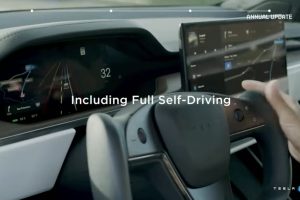A preliminary study on the Tesla Model S crash in Texas last month has been published by the National Transportation Safety Board. According to the NTSB, testing of an exemplar car near the accident site showed that Autosteer “was not available on that part of the road.” The NTSB, on the other hand, could engage Tesla’s Traffic Aware Cruise Control during its testing.
The crash occurred on April 17th, 2021, near Spring, Texas. According to initial reports, the vehicle was equipped with the ability to operate with Tesla’s advanced driver assistance system, Autopilot. Autopilot, on the other hand, is not accessible on any public road in the world. Although mass media outlets immediately concluded that Autopilot was to blame for the crash after allegations that the Model S was “driverless,” the NTSB and NHTSA declared that they would conduct an investigation to ascertain if the vehicle was using Autopilot at the time of the accident.
The owner entered the driver’s seat and the passenger entered the front passenger’s seat, according to NTSB findings obtained from a surveillance camera at the owner’s house. “The video also shows the car slowly entering the roadway and then accelerating down the road away from the camera and out of sight,” the NTSB added.
The collision was violent, the Model S caught fire after colliding with a tree, killing both occupants. According to the report, the vehicle caught fire when it collided with the high-voltage lithium-ion battery case. The car was destroyed by the fire, but it was extinguished in less time than had been reported. Palmer Buck, the Woodland Township Fire Department’s Fire Chief, talked to the media about rumors that the fire had burned for four hours. This was untrue, as Chief Buck reported that the fire was extinguished in two to three minutes.
The biggest problem after the accident was whether the car was on Autopilot or not. The National Transportation Safety Board (NTSB) tested a Model S that was involved in the crash and discovered that it could not be activated where the accident occurred.
The NTSB wrote explicitly:
“The vehicle was equipped with Autopilot, Tesla’s advanced driver assistance system. Using Autopilot requires both the Traffic Aware Cruise Control and the Autosteer systems to be engaged. 2 NTSB tests of an exemplar car at the crash location showed that Traffic Aware Cruise Control could be engaged but that Autosteer was not available on that part of the road.”
Several components of the vehicle, including the Onboard Storage Device in the Infotainment console, were not recovered by the agency. The car’s restraint module, which provides data on vehicle speed, belt status, acceleration, and airbag deployment, was recovered but severely damaged by fire. According to the study, the restraint control module was taken to the National Transportation Safety Board’s (NTSB) recorder laboratory for examination.
The NTSB is gathering data to assess accident dynamics, postmortem toxicology test findings, seat belt usage, passenger egress, and electric vehicle fires as part of its inquiry.
The NTSB added:
“All aspects of the crash remain under investigation as the NTSB determines the probable cause, with the intent of issuing safety recommendations to prevent similar crashes. The NTSB is working alongside the Harris County Texas Precinct 4 Constable’s Office, which is conducting a separate, parallel investigation. The National Highway Traffic Safety Administration and Tesla are supporting the NTSB in the investigation.”
The NTSB’s preliminary report is available below.





